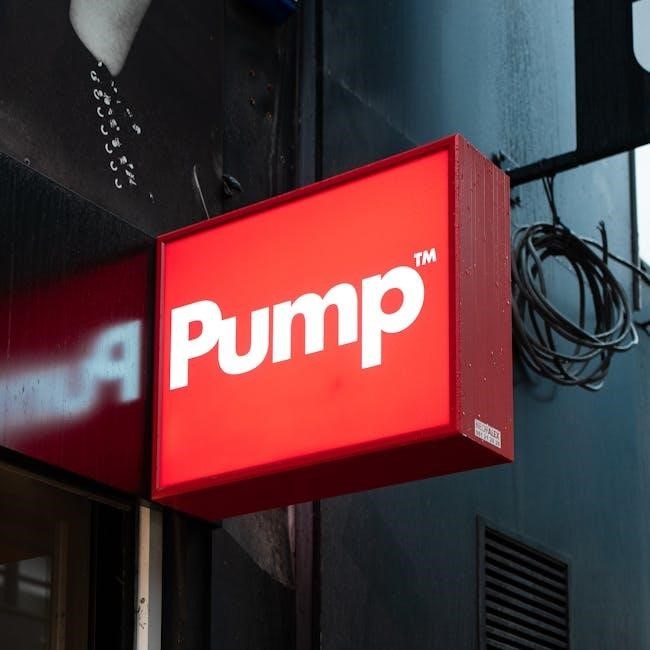The pump guide provides essential information on pump selection and operation‚ including key considerations and terminology‚ using
basic elements
to ensure optimal performance and efficiency always matters.
Basic Elements of a Pump
The basic elements of a pump include the housing‚ impeller‚ and diffuser‚ which work together to transfer energy to the fluid being pumped.
The housing protects the hydraulic section of the pump‚ while the impeller causes and directs movement of the fluid inside the pump.
The diffuser turns the energy transferred to the fluid by the impeller into pressure‚ allowing the fluid to be pumped efficiently.
Other key elements include the mechanical seal‚ which prevents the fluid from coming into contact with the electric motor‚ and o-rings‚ which adapt the various parts of the pump.
These basic elements are essential for the proper functioning of the pump and must be carefully considered when selecting a pump for a particular application.
The pump’s hydraulic section is also a critical component‚ and its design and construction can significantly impact the pump’s performance and efficiency.
Understanding the basic elements of a pump is crucial for selecting the right pump and ensuring optimal performance.

Types of Pumps
Various pumps exist‚ including centrifugal‚ positive displacement‚ and rotary pumps‚ each with unique characteristics and applications always needing specific considerations and terminology.
Centrifugal Pump Types
Centrifugal pumps are classified into several types‚ including overhung‚ between-bearings‚ and vertically-suspended pumps‚ each with its own unique characteristics and advantages. The overhung type is the most common and is used in a wide range of applications. Between-bearings pumps are typically used for higher-flow and higher-pressure applications‚ while vertically-suspended pumps are often used in sump and pit applications. Other types of centrifugal pumps include single-stage and multi-stage pumps‚ as well as pumps with different impeller designs‚ such as axial-flow and radial-flow impellers. Understanding the different types of centrifugal pumps is essential for selecting the right pump for a specific application. The pump guide provides detailed information on the different types of centrifugal pumps‚ including their characteristics‚ advantages‚ and disadvantages‚ to help users make informed decisions. This information is crucial for ensuring optimal pump performance and efficiency.

Pump Selection Guide
The guide helps users select the right pump using
various factors
and considerations always.
Key Considerations for Pump Selection
The process of selecting a pump involves several key considerations‚ including the type of fluid being pumped‚ the desired flow rate‚ and the system’s operating pressure.
Additional factors such as the pump’s materials of construction‚ energy efficiency‚ and maintenance requirements must also be taken into account.
A thorough understanding of these considerations is essential to ensuring the optimal performance and longevity of the pump‚ as well as the overall system.
By carefully evaluating these factors‚ users can select a pump that meets their specific needs and provides reliable service over time‚ minimizing downtime and reducing maintenance costs.
Furthermore‚ considering the pump’s compatibility with the system’s piping and instrumentation is crucial to prevent potential issues and ensure a smooth operation;

Pump Terminology
Understanding pump terminology is crucial using
specific terms
to describe pump components and operations always.
Definitions of Centrifugal Pump Terms
The definitions of centrifugal pump terms are essential to understanding pump operation and selection‚ including terms such as impeller‚ diffuser‚ and mechanical seal‚ which are critical components of a centrifugal pump;
These terms are used to describe the various parts of a centrifugal pump and their functions‚ and are commonly used in the pump industry to specify pump requirements and characteristics.
A thorough understanding of these terms is necessary to ensure proper pump selection and operation‚ and to troubleshoot any issues that may arise during pump use‚ using online resources and guides to learn more about centrifugal pump terms and their applications.
By learning these terms‚ users can better understand how centrifugal pumps work and how to select the right pump for their needs‚ and online resources can provide more information on centrifugal pump terms and their uses.

Pump Sizing and Selection Tools
Using software tools like PUMP-FLO for sizing and selecting pumps ensures optimal performance and efficiency always matters in pump operation and maintenance systems online.
Pump Sizing Software
Pump sizing software is a crucial tool in the pump selection process‚ allowing users to input specific application requirements and receive recommendations for the most suitable pump. This software takes into account various factors such as flow rate‚ pressure‚ and fluid characteristics to ensure optimal pump performance. By utilizing pump sizing software‚ users can streamline the selection process and reduce the risk of incorrect pump sizing‚ which can lead to decreased efficiency and increased energy costs. The software can also provide detailed reports and curves‚ enabling users to make informed decisions about their pump needs. Additionally‚ many pump manufacturers offer their own pump sizing software‚ such as PUMP-FLO‚ which can be used to select and size pumps for a wide range of applications‚ including industrial‚ commercial‚ and residential uses‚ with various features and benefits.
Proper pump selection is crucial for optimal performance‚ using
relevant data
to ensure efficiency and reduce costs always matters effectively online.
Importance of Proper Pump Selection
The importance of proper pump selection cannot be overstated‚ as it has a significant impact on the overall efficiency and cost-effectiveness of the system. A well-selected pump can provide reliable operation‚ minimize energy consumption‚ and reduce maintenance costs. On the other hand‚ a poorly selected pump can lead to reduced performance‚ increased energy consumption‚ and higher maintenance costs. Proper pump selection involves considering various factors‚ including the type of fluid being pumped‚ the flow rate‚ and the pressure required. By selecting the right pump for the application‚ users can ensure optimal performance‚ reduce costs‚ and minimize downtime. Using relevant data and resources‚ such as pump selection guides and software‚ can help users make informed decisions and choose the best pump for their needs. This can lead to improved overall system performance and reduced operating costs.